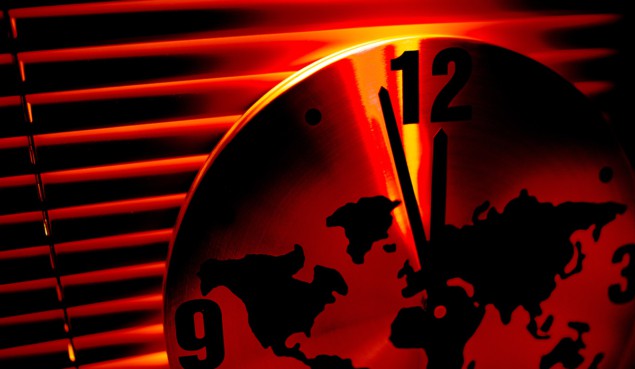In this article (originally published in Lateral Thoughts, Physics World’s regular column of humorous and offbeat essays, puzzles, crosswords, quizzes and comics, which appears on the back page of the print edition) Peter Wright muses on how various Doomsday scenarios could be measured, by proposing a set of numbers that are as significant as R

I was recently reading through an update on the current COVID-19 situation, with particular reference to the number of secondary infections, R, produced by a single infected person. It suddenly dawned on me that, in the past, I had often encountered numbers that have exactly the same significance as R, but in other situations, with the potential for global disruption of the integrity and wellbeing of the planet. In essence, if the number exceeds 1.0 then the effect becomes divergent, or in more dramatic terms a chain-reaction occurs; whereas for a level below 1.0 the effect will be convergent towards zero. Being mindful of the Doomsday Clock with which most scientists, as well as readers of Physics World, are familiar, I have come to think of these numbers as “Doomsday numbers”.
In the case of the SARS-CoV-2 virus, with a Doomsday number R greater than 1.0 the infection will strike everybody, unless it is checked by the natural immunity of those recovering from infection, or by induced immunity by vaccine. Essentially, the infection will terminate when whole populations have gained immunity. It seems logical to expect any form of intervention such as temporary isolation, or protective equipment, would result in alternating periods of spikes and recovery; very reminiscent of a simple harmonic motion, and would only prolong the passage towards herd immunity. Sadly, as with all serious health issues, there will be some sections of a community with very poor outcomes.
In August 1939 Albert Einstein wrote to the US president Franklin D Roosevelt, alerting him to the real possibility of the development of an atomic weapon based on the fission of uranium and of its possible use by a potential enemy. Einstein quoted convincing research by Leo Szilard and Enrico Fermi to substantiate his warning. After consultation with his own group of scientists the president approved the production of an atomic bomb and in November 1942 work began at Los Alamos.
A week later, working independently with their nuclear reactor in Chicago, Enrico Fermi and his team achieved the first sustained nuclear chain reaction in the 235 isotope of uranium. During its work the team used its own Doomsday number, k, to assess the progress of the reaction. Fermi defined k as the average number of secondary neutrons produced by one original neutron in a lattice of infinite size. They were, of course, seeking a k value of more than 1.0.
This subsequently led to the design and construction of the first atomic weapons, eventually dropped on two Japanese cities in 1945. The safe operation of the pile depended critically on the manual lifting and lowering of neutron-absorbing rods. The brilliant but rather naive Fermi later expressed the hope that with the dramatic end to the war, emphasis would be shifted from weapons to peaceful applications of nuclear energy, such as energy production and uses in medicine. He hoped it would be “hailed for the advantages that it may bring to man, never being feared on account of its destructive possibilities”.
In view of its potential implications on global resources it seems appropriate to ascribe a unique Doomsday number to global population, which we may call P. The number would reflect the global balance of births over deaths. Overpopulation of the planet has implications of crop shortage, collapse of ecosystem services, overfishing, scarcity of safe drinking water and deforestation, along with many others. Since the end of World War Two, the average family unit has decreased steadily from around 7 in 1950 to around 4.5 today. Assuming that most families contain two adults these figures suggest that P remains doggedly above 1.0, with the current global population increasing towards 8 billion.
If I was a little more adventurous and a lot more imaginative, I might propose further that all Doomsday numbers are somehow connected
It is tempting to suggest that other global threats such as pollution and climate change have their own Doomsday numbers associated with them, which we may call Pn and C respectively. If I was a little more adventurous and a lot more imaginative, I might propose further that all Doomsday numbers are somehow connected. Indeed, I may even attempt to formulate a relationship between R, C and P, or between P, R and Pn.
Many scientists have voiced concerns over the rapid pace at which technology has advanced and many view the recent surge as a multi-pronged threat to humankind and the environment. In particular artificial intelligence (AI), which seems to be spreading its influence into increasingly more aspects of human activity, causes anxiety for many. As long ago as 1951 that brilliant mathematician and computer scientist, Alan Turing, shared his concerns that future super-intelligent, possibly hostile, AI may pose a threat to humans. Much later, Stephen Hawking worried that AI “could spell the end of the human race”.

Doomsday Clock ticks closer to disaster
The derivation of the Doomsday numbers of every threat would be a challenging, if not impossible, task but in return they would offer guidance towards recovery. In the meantime, perhaps we should be mindful that in January 2020 the Doomsday Clock was set at 100 seconds to midnight, the closest it has been since its inception in 1947. I for one feel terrifyingly close to those final deafening chimes – or should that be final Big Bang?



